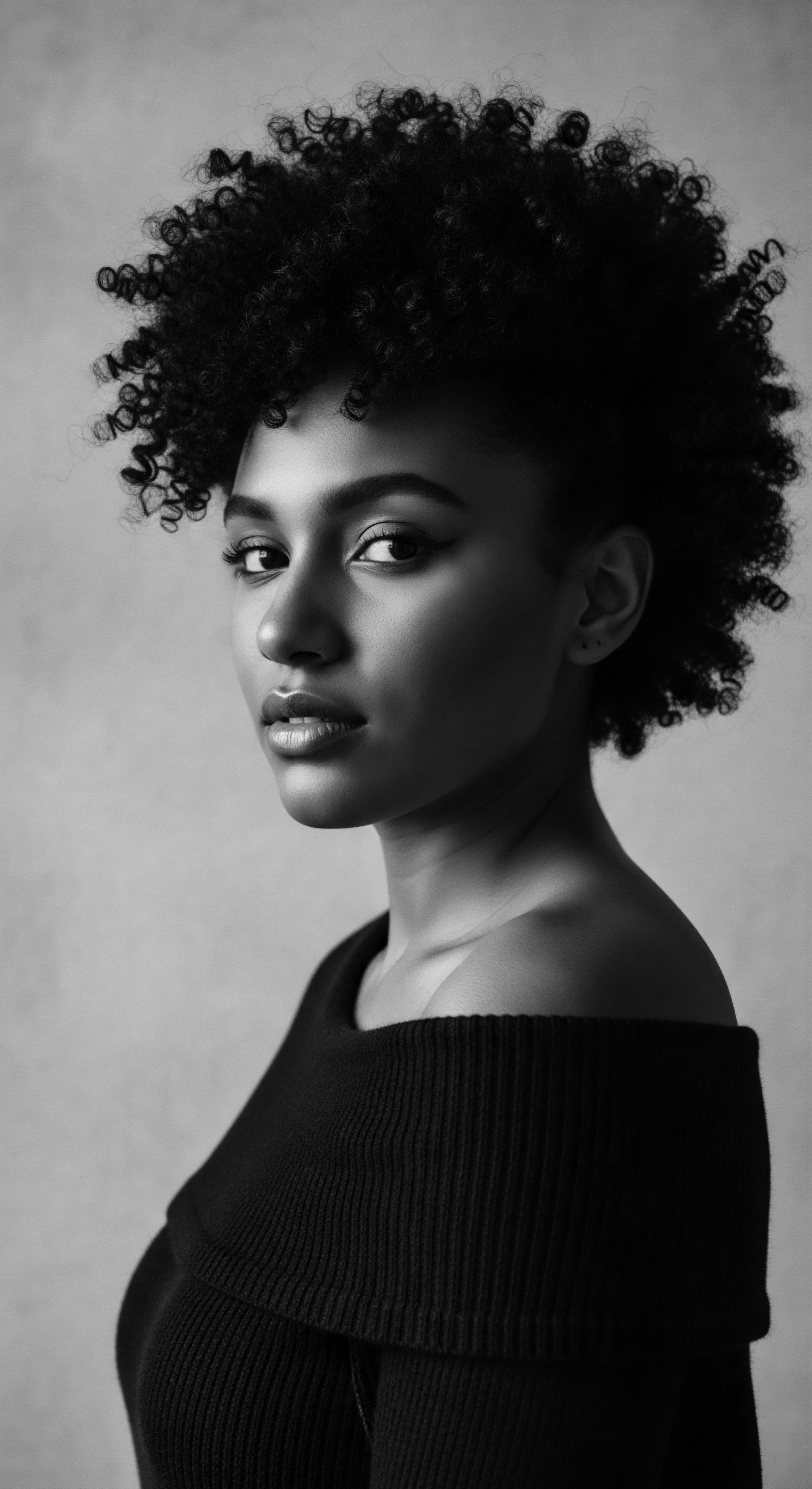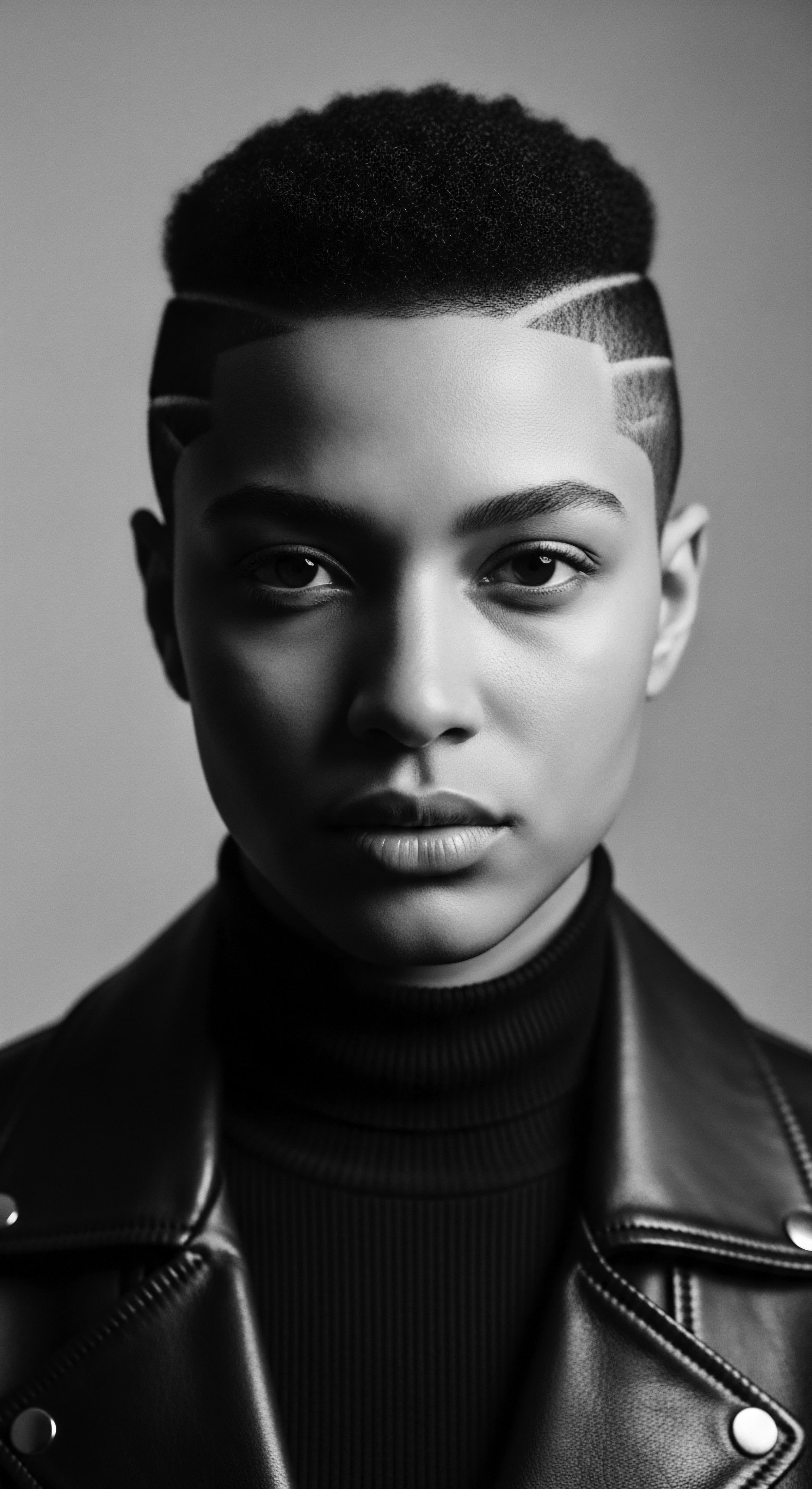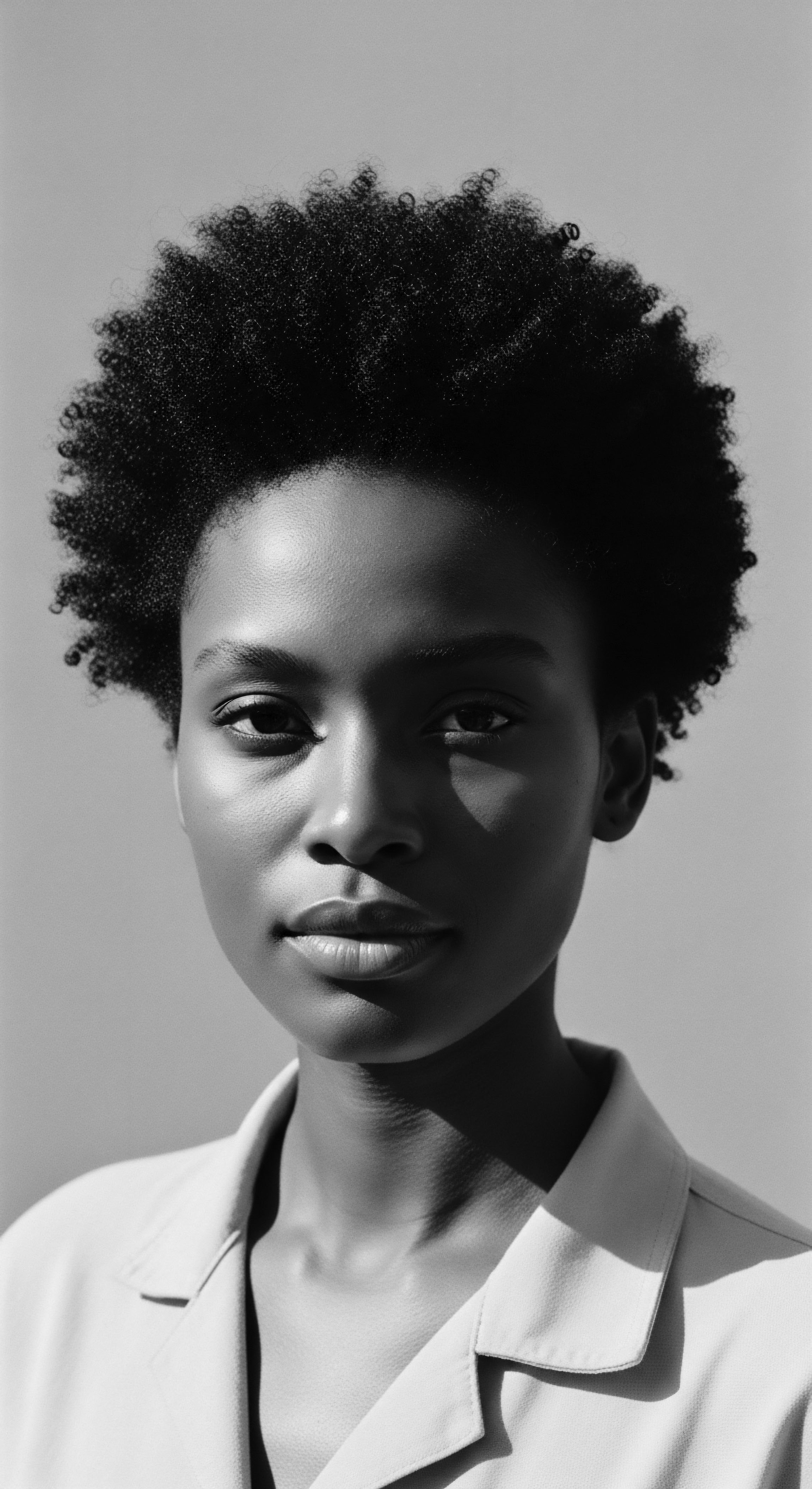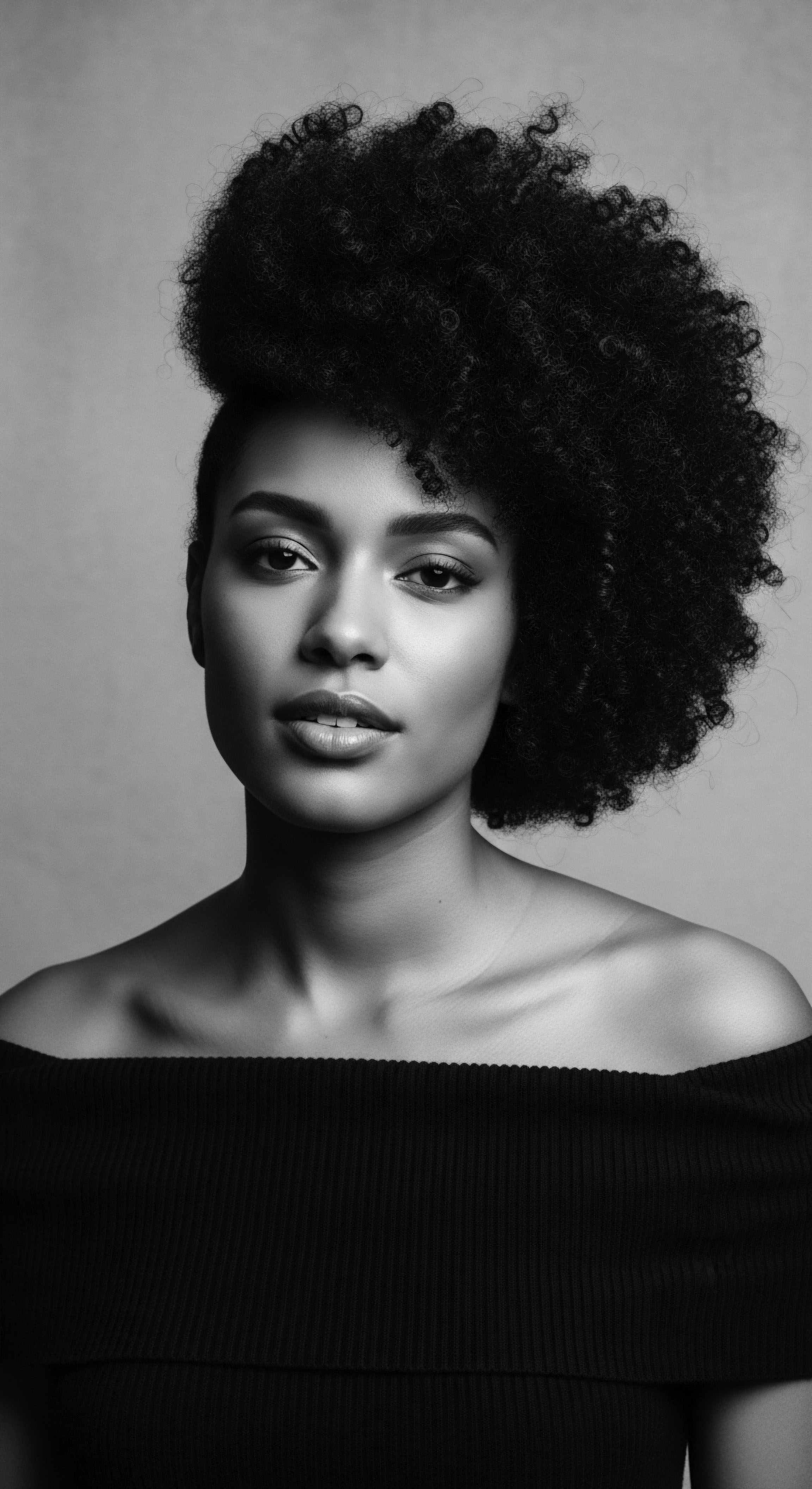
Roots
For those of us whose lineage holds the rich, coiling narratives of Afro-textured hair, a strand is never simply a strand. It is a living echo, a whisper from ancestral plains, a testament to resilience woven through generations. This exploration begins at the very source, examining how deeply rooted historical protective styles shielded Afro-textured hair from the ceaseless demands of climate, labor, and indeed, life itself.
Our journey into hair’s fundamental nature, its anatomy, and the language used to describe it, reveals threads of continuity from ancient wisdom to contemporary understanding. It is a story not just of beauty, but of survival, identity, and the enduring power of heritage.

The Sacred Structure of Textured Hair and Ancient Safeguards
Afro-textured hair, with its remarkable helical twists and turns, possesses an inherent poetry. Its unique elliptical cross-section and higher density of disulfide bonds contribute to its distinct spring and volume. Yet, these very qualities, which lend such visual splendor, also present particular challenges.
The coiling structure, while providing a natural barrier against the sun’s direct assault, also means that natural oils from the scalp struggle to travel down the hair shaft, leaving the ends more vulnerable to dryness. Furthermore, the points where the cuticle lifts along the twists are areas more susceptible to damage, making textured hair inherently more fragile than straighter types.
In ancient civilizations, this nuanced biological reality was observed and understood through generations of lived experience. Rather than scientific instruments, observation and communal practice shaped adaptive care routines. These practices often included styles that minimized manipulation, offered physical shielding, and used natural emollients to combat environmental harshness. Such wisdom, passed down through the ages, laid the groundwork for what we now categorize as “protective styling.”
Ancestral approaches to textured hair care were deeply intertwined with its biological characteristics, fostering styles that preserved health against environmental factors.

Echoes from the Source ❉ Hair’s Earliest Protectors
The earliest forms of protective styling served not only practical ends but also held profound cultural and social meaning. From Namibia around 3500 BC, the practice of twisting and braiding emerged, evolving into complex patterns that communicated a person’s social status, marital status, age, ethnicity, or even their family name within West African societies by the 1400s. These intricate styles, often taking hours or even days to create, reduced daily handling and exposure, thereby inherently protecting the strands.
In ancient Egypt, wigs served a dual purpose ❉ they were markers of status and, quite practically, offered protection from the intense sun and reduced the risk of lice. While often made from human hair or plant fibers and elaborately adorned, these wigs also represented a sophisticated approach to hair preservation in a challenging climate. Similarly, hair wraps, a tradition still seen in various African communities today, symbolized tribe or status and offered a shield against heat and moisture loss.
The ingenuity of these early practices speaks to a deep connection with the hair itself, recognizing its need for shelter and gentle handling. The use of natural substances, too, was a cornerstone. The Hima tribe of Namibia, for instance, relied on nature for hair care, using a paste of ochre and animal fat, applied to braided hair, which remained for months to moisturize and protect the strands. This ancestral reliance on the earth’s bounty for hair’s longevity is a profound testament to their understanding of protective principles.
One remarkable historical example highlighting the protective genius of ancestral practices during periods of severe duress concerns the cornrows of enslaved Africans. During the transatlantic slave trade and the subsequent period of enslavement in the Americas, braids, especially cornrows, became more than mere hairstyles. They served as a covert means of communication and a practical method for survival. Enslaved people would braid rice and seeds into their hair, smuggling these vital grains from Africa to the Americas, and later, if they managed to escape, planting them to create a food source (Creative Support).
This poignant act illustrates how a protective style, worn to preserve the hair from the harsh conditions of forced labor and neglect, simultaneously functioned as a tool for resistance, cultural preservation, and the literal sustenance of life. The tightly woven patterns of cornrows, which minimized tangling and breakage, also doubled as maps for escape routes, embedding crucial information within the very strands of their heritage (Alicia Tenise, 2019).
| Ancient Practice Braids and Twists (e.g. Cornrows) |
| Protective Function Reduced manipulation, minimized tangling, sealed ends, offered physical barrier against elements. |
| Cultural or Modern Connection Foundational styles for modern protective looks; symbolize identity, resilience, and community. Continued use in communication and cultural expression. |
| Ancient Practice Wigs (Ancient Egypt) |
| Protective Function Shielded natural hair from sun and dirt, reduced lice risk, maintained cool scalp. |
| Cultural or Modern Connection Historical precursor to modern extensions and hairpieces, demonstrating early understanding of scalp and hair protection from elements. |
| Ancient Practice Hair Wraps/Headwraps |
| Protective Function Protected hair from environmental damage, retained moisture, maintained style. |
| Cultural or Modern Connection Continues as a versatile, fashionable, and practical protective measure, deeply connected to African traditions of status and identity. |
| Ancient Practice Clay and Oil Treatments (e.g. Himba tribe) |
| Protective Function Moisturized, sealed cuticles, strengthened strands, provided long-term environmental shielding. |
| Cultural or Modern Connection Inspires contemporary natural hair oiling and deep conditioning routines, emphasizing natural ingredients for hydration and strength. |
| Ancient Practice These ancestral practices reveal a profound understanding of hair care and protection, long before scientific categorization. |

How Did Cultural Understanding Shape Early Hair Care?
The relationship between cultural understanding and early hair care was symbiotic. Hair was often considered a living part of the self, imbued with spiritual significance and social messages. This reverence naturally led to practices that prioritized its health and preservation.
In many African societies, the time spent styling hair was a communal ritual, a moment for bonding, sharing wisdom, and reinforcing social ties. The meticulous nature of these sessions ensured careful handling, reducing the likelihood of damage that modern, rushed routines sometimes create.
The Yoruba of Nigeria, for instance, believed hair to be the most elevated part of the body, connecting individuals to the spiritual realm, and braided hair could convey messages to the gods. Such a belief system naturally fostered a gentle, intentional approach to care. The emphasis on thick, long, clean, and neat hair in pre-colonial Africa signified the ability to produce bountiful farms and healthy children, establishing hair health as a marker of well-being and prosperity. This holistic view meant that protective styles were not just about aesthetics; they were an affirmation of life, spirit, and community.

Ritual
The journey into textured hair heritage leads us from the foundational understanding of its biological makeup to the living, breathing rituals that have sustained its health and beauty through millennia. These are not merely actions; they are conversations with the past, dialogues with our ancestors, and deliberate acts of self-care rooted in profound cultural wisdom. The protective styles that shielded Afro-textured hair from damage were, at their heart, sacred rituals, passed down through generations, each movement a testament to communal knowledge and a deep respect for the hair strand.

What Ancestral Techniques Underpinned Protective Styling?
Ancestral techniques for protective styling were diverse, born from varied environments and cultural expressions across Africa. They represent a sophisticated, empirically developed science of hair preservation. At the core of these methods lay the principle of minimizing external stressors and preserving the hair’s inherent moisture. This was achieved through intricate coiling, intertwining, and gathering of the hair, often close to the scalp, providing a shield against environmental elements and daily manipulation.
- Coiling ❉ Many early protective styles involved coiling sections of hair, sometimes around itself, sometimes with the aid of natural fibers or extensions. This technique, seen in styles like Bantu knots, which hail from the Zulu tribes, minimized exposed surface area and held moisture within the coil.
- Braiding ❉ Beyond simple plaiting, African braiding developed into a complex system of interlocking strands, such as cornrows and box braids, originating thousands of years ago in South Africa. These tightly woven patterns secured the hair, preventing tangles and breakage, and could last for weeks, reducing the need for daily combing.
- Threading ❉ African threading, used for centuries, involved wrapping hair with thread to lengthen and straighten it without heat. This technique not only offered a beautiful style but also served to stretch the hair, making it less prone to tangling and subsequent breakage, a crucial aspect of length retention.
These methods, meticulously performed, were often communal affairs, transforming hair care into a cherished social event where knowledge was shared and bonds strengthened. The careful sectioning, detangling, and application of natural emollients before styling ensured that the hair was prepared for its protective enclosure, reflecting a thoughtful, intentional approach to care that resonates deeply with modern holistic wellness practices.
Traditional hair care rituals prioritized minimal manipulation and natural ingredients, safeguarding hair health through centuries of collective wisdom.

How Did Traditional Tools Complement Protective Practices?
Traditional tools were extensions of the hands that carefully tended to textured hair, designed with an intuitive understanding of its specific needs. Unlike modern brushes that might snag coils, ancestral combs, often carved from wood or bone, featured widely spaced, rounded teeth, crafted to gently detangle and distribute natural oils without causing undue stress to the delicate strands. These combs, sometimes adorned with symbolic carvings, carried cultural meaning, reflecting one’s group affiliation or personal history.
The very process of creating elaborate styles required specific implements. For intricate braiding, skilled hands were paramount, sometimes aided by simple bone or wooden picks to part and smooth sections. For hair oiling, gourd containers or smoothed stone vessels held the precious plant extracts and butters.
The tools themselves were often simple, yet their efficacy lay in their design and the experienced hands that wielded them, always prioritizing the preservation of the hair’s integrity. These tools stand as testaments to the ingenuity of communities adapting to their environment, creating what was needed from the natural world to support hair health and beauty.

Ancestral Ingredients and Their Protective Chemistry
Beyond the techniques and tools, the very earth offered its bounty to shield Afro-textured hair. Traditional hair care relied heavily on natural ingredients, many of which are now being rediscovered and validated by modern science for their beneficial properties. These substances were not merely applied; they were often part of a deliberate, long-term regimen designed to moisturize, strengthen, and protect.
Consider the Basara Tribe of Chad, whose practice of applying a mixture of herbs and raw oil (often referred to as Chebe Powder) to their hair weekly, followed by braiding, is a testament to length retention. Chebe, a blend of various herbs, is believed to strengthen hair strands and retain moisture between washes, preventing breakage. This traditional practice highlights a deep understanding of how to fortify hair against environmental elements and manipulation. The application of this mixture, then sealing it with braids, created a powerful, long-lasting protective barrier.
Similarly, Shea Butter, derived from the nuts of the shea tree, has been a cornerstone of West African hair care for centuries. Its rich emollient properties provide deep moisture, protecting the hair from harsh environmental conditions and promoting healthy growth. Women in Ghana and Nigeria, among other regions, have used shea butter to shield their hair, showcasing an intuitive grasp of natural lipids as protective agents.
Other ingredients like Marula Oil, known for its light absorption and moisture-sealing abilities, and Ambunu from Chad, a cleanser that also treats itchy scalp and fights dandruff, were utilized for their multifaceted benefits. Rhassoul Clay from Morocco served as a cleanser and exfoliator, removing buildup from the scalp while leaving hair hydrated. These natural offerings were not merely cosmetic; they performed vital protective and restorative functions, demonstrating a sophisticated understanding of hair biology derived from generations of observation and practice. The wisdom embedded in these ancestral ingredients points to a profound connection to the land and its ability to nourish and protect.

Relay
The journey of historical protective styles from ancient practices to contemporary expression represents a powerful relay of ancestral wisdom across continents and centuries. This segment delves into the complexities of this heritage, examining how the foundational elements of hair protection evolved, adapted, and sometimes endured through periods of profound societal change, always with a deep, unbreakable connection to textured hair heritage and the experiences of Black and mixed-race communities. It is a story of resilience, adaptation, and the unwavering assertion of identity through hair.

How Did Forced Migration Influence Protective Styles?
The transatlantic slave trade unleashed a devastating impact on African communities, disrupting countless cultural traditions, including intricate hair rituals. Upon arrival in the Americas, one of the first acts of dehumanization inflicted upon enslaved Africans was the forced shaving of their heads. This violent act served to strip individuals of their identity, severing a profound connection to their cultural heritage and spiritual practices, as hair was a powerful symbol of status, tribe, and self.
Despite this brutal attempt at erasure, the deep-seated knowledge of protective styling persisted, adapting to new, often harrowing, circumstances. Hair care, now limited to sparse opportunities, became a functional necessity for survival and a subtle act of resistance. Styles like cornrows, already deeply rooted in African heritage, proved to be highly practical. They could last for an entire week, minimizing manipulation and protecting the hair in arduous conditions, while also serving as a secret messaging system for communication and even mapping escape routes.
This period highlights the remarkable adaptability of protective styles, transforming from overt cultural statements to covert tools for survival and cultural preservation, a testament to the enduring spirit of textured hair heritage even in the face of oppression. (Alicia Tenise, 2019).
Protective hair practices became a quiet yet powerful form of resistance and cultural continuity during periods of forced displacement and subjugation.

What Modern Science Confirms Ancestral Wisdom?
Modern scientific understanding often validates the intuitive wisdom of ancestral hair care practices. Textured hair, particularly Afro-textured hair, possesses unique characteristics that make protective styling especially beneficial. The elliptical cross-section and high curl density of Afro-textured hair create points where the cuticle (the hair’s outer protective layer) is more susceptible to lifting, making it prone to moisture loss and breakage. This inherent fragility means that minimizing manipulation and environmental exposure is crucial for maintaining hair health.
Science explains why styles like braids and twists are so effective ❉ they reduce the need for daily combing and styling, thereby decreasing mechanical stress on the hair shaft. By keeping the hair bundled, these styles help to maintain the integrity of the cuticle, reducing friction and preventing tangles that lead to breakage. Moreover, protective styles can help retain moisture, a perennial challenge for Afro-textured hair where natural oils struggle to traverse the coiled path from scalp to tip. The protective qualities of natural ingredients, like those in Chebe powder or Shea butter, are also being explored.
Shea butter, for instance, is rich in fatty acids that help form a protective barrier, reducing water loss and external damage. The efficacy of these traditional practices aligns with contemporary dermatological recommendations for textured hair care, emphasizing moisture retention, minimal manipulation, and gentle handling. This scientific validation underscores the authority and enduring relevance of heritage practices.
A study conducted by Mbilishaka and her colleagues examined hair discrimination within Black communities, finding that Black women and men often experienced bias both at home and in public settings like schools. This research highlights the socio-cultural pressures that have historically driven Black individuals away from their natural hair textures and towards styles perceived as more ‘acceptable’ by Eurocentric standards, often involving damaging chemical or heat treatments. The movement towards protective styles and the embrace of natural hair in modern times can be seen as a direct counter-narrative to these historical pressures, reflecting a renewed value for the protective qualities inherent in ancestral practices and a reclaiming of cultural identity. (Mbilishaka et al.)

How do Protective Styles Voice Identity and Shape Futures?
Protective styles today are more than just hair care; they are a powerful lexicon of identity, a vibrant expression of heritage, and a conscious shaping of future narratives. In the wake of centuries of attempts to erase Black identity through hair suppression, the embrace of natural and protective styles has become a profound act of self-acceptance and resistance. The modern natural hair movement, tracing its origins to the Black Power movements of the 1960s and 1970s, champions Afro-textured hair as a symbol of pride and defiance against Eurocentric beauty standards.
Wearing braids, twists, or locs today connects individuals directly to their ancestral lineage, serving as a tangible link to the ingenuity and resilience of those who came before. These styles allow for a celebration of diverse African aesthetics while actively safeguarding hair health. This deliberate choice reduces reliance on heat or chemical straightening, practices that have historically led to significant damage and scalp issues in textured hair.
The increasing mainstream popularity of protective styles, coupled with legislative efforts like the CROWN Act, which aims to prevent hair discrimination, signifies a societal shift towards greater acceptance and reverence for textured hair. This ongoing relay of knowledge, from ancient wisdom to contemporary advocacy, shapes a future where textured hair is universally recognized for its beauty, versatility, and deep cultural heritage.

Reflection
Standing at this juncture of historical memory and present-day understanding, we perceive the enduring significance of ancestral protective styles. The journey of Afro-textured hair is truly a living archive, each coil and twist holding within it the ‘Soul of a Strand’—a spirit of survival, an echo of ingenuity, and a declaration of persistent beauty. What shielded Afro-textured hair from damage throughout history was not merely a set of techniques, but a profound relationship with self, community, and the natural world. This wisdom, born from necessity and refined over countless generations, continues to illuminate our path toward holistic hair care.
The resilience of these heritage practices, from the meticulous braiding that conveyed status and mapped escape routes to the use of earth’s generous offerings like shea butter and ancestral clays, reminds us that true care is timeless. It prompts a contemplation of our own connection to the strands that crown us, inviting us to view them not as a challenge, but as a sacred inheritance. In every conscious choice to nurture textured hair, to honor its unique architecture, and to embrace the styles that once safeguarded our forebears, we participate in an unbroken continuum of heritage, weaving the past into the vibrant fabric of our present and future.

References
- Alicia Tenise. (2019, May 6). Cultural Significance of Braids. Retrieved from https://aliciatenise.com/cultural-significance-of-braids/
- Creative Support. (n.d.). The History of Black Hair. Retrieved from https://www.creativesupport.co.uk/news/the-history-of-black-hair/
- DermNet. (n.d.). Hair care practices in women of African descent. Retrieved from https://dermnetnz.org/topics/hair-care-practices-in-women-of-african-descent
- Hexis Lab. (n.d.). Genomic Variation in Textured Hair ❉ Implications for Holistic Hair Care. Retrieved from https://hexis-lab.com/blogs/news/genomic-variation-in-textured-hair-implications-for-holistic-hair-care
- MDPI. (2022, January 26). Afro-Ethnic Hairstyling Trends, Risks, and Recommendations. Retrieved from https://www.mdpi.com/2079-9292/11/3/366
- The Afro Curly Hair Coach. (2023, March 3). CHECK OUT THESE TRADITIONAL HAIRCARE TREATMENTS. Retrieved from https://afrocurlyhaircoach.com/blogs/news/traditional-haircare-treatments
- The Past. (2025, February 20). The magic and power of hair in ancient Egypt. Retrieved from https://the-past.com/feature/the-magic-and-power-of-hair-in-ancient-egypt/
- Wimpole Clinic. (n.d.). Hair Anatomy, Hair Diagrams and The Mechanisms of Hair Loss. Retrieved from https://www.wimpoleclinic.com/blog/hair-anatomy/
- Psi Chi. (n.d.). PsychoHairapy ❉ Brushing Up on the History and Psychology of Black Hair. Retrieved from https://www.psichi.org/news/psichi_notes/psycho-hairapy.aspx
- Afriklens. (2024, November 1). African Hairstyles ❉ Cultural Significance and Legacy. Retrieved from https://afriklens.com/blogs/news/african-hairstyles-cultural-significance-legacy
- Seppic. (2025, January 10). Understanding hair types ❉ 4 natural textures, physiology and needs. Retrieved from https://www.seppic.com/en/understanding-hair-types-4-natural-textures-physiology-and-needs
- Egypt Tours Portal. (2024, December 8). Ancient Egyptian Clothing and Fashion ❉ Style, Status, and Sacred Symbolism. Retrieved from https://www.egypttoursportal.com/ancient-egyptian-clothing-and-fashion/
- Africa Imports. (2025, January 13). Traditional African Secrets For Long And Healthy Hair. Retrieved from https://africaimports.com/blogs/afro-hair-care-products/traditional-african-secrets-for-long-and-healthy-hair
- Rolling Out. (2025, March 30). Hidden meanings behind African American braiding styles. Retrieved from https://rollingout.com/2025/03/30/hidden-meanings-behind-african-american-braiding-styles/
- The Gale Review. (2021, November 23). African Hairstyles – The “Dreaded” Colonial Legacy. Retrieved from https://gale.com/intl/resources/gale-review/african-hairstyles-the-dreaded-colonial-legacy
